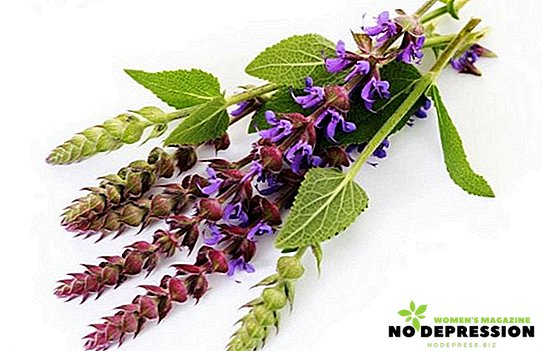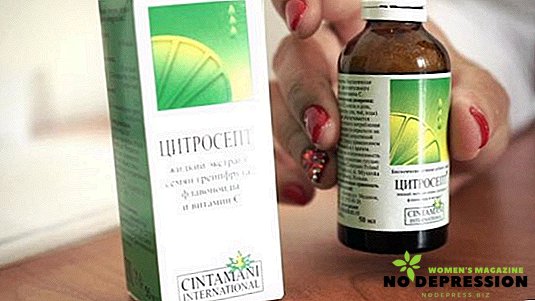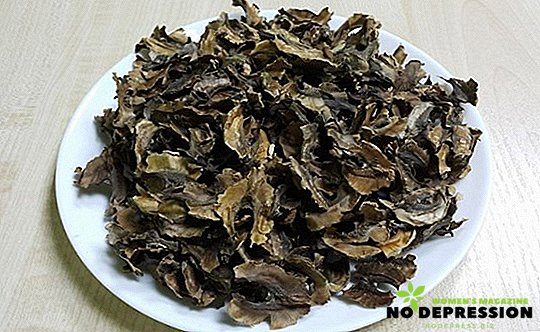The healing properties of sage have been known since ancient times, thanks to which today the plant is widely used both in traditional and traditional medicine. It has a beneficial and therapeutic effect on the body, and this is due to its rich vitamin-mineral composition. Sage-based products have a disinfectant, analgesic and antipyretic effect, but there are some limitations to their use.

What is Salvia officinalis
Such a plant as sage, has been known for a long time and is widely used in alternative medicine. The grass is perennial and grows in the form of a shrub up to 70 cm. The plant has a branched stem, pubescent along its entire height, covered with a brown or gray shell.
If you rub sage leaves between your fingers, then you feel a tart pleasant aroma. The plant propagates with seeds that grow quite large, up to 3 mm in diameter. Growing sage is not difficult, but it must be borne in mind that the plant is light-loving and does not tolerate high humidity. For the winter, it is necessary to sprinkle it with dry branches or leaves, and also wrap it with a film.
Chemical composition
The healing properties of the plant are due to its unique chemical composition. Often it is used by pharmacists for the preparation of various modern medicines.
 Leaves contain large quantities:
Leaves contain large quantities:
- phytoncides;
- flavonoids;
- alkaloids;
- phytonutrients;
- organic acids;
- tannins.
The strong aroma of the plant gives oil, which is present in flowers and leaves. It has a powerful antimicrobial effect and is used for the preparation of medicines and cosmetics.
Sage is considered a source of electrolytes such as potassium and magnesium, as well as fiber, vitamins and minerals. Interesting from the point of view of valuable substances are the fruits of the plant, which are almost a quarter of the fatty oil.
Useful properties of sage
Sage has:
- antipyretic;
- antiseptic;
- diuretic;
- hemostatic;
- astringent;
- anti-inflammatory;
- disinfectant action.
Plant-based medicines are widely used to correct the pathologies of the digestive system, kidneys, liver and viral infections. In addition, with their help, it is possible to alleviate the patient's condition for sore throat, neuritis, radiculitis, gingivitis and bronchitis.
Sage is widely used in gynecology to eliminate diseases such as thrush, cervical erosion. In addition, it is believed that this herb can help in the treatment of male and female infertility. With its help, it is possible to normalize hormones, restore the menstrual cycle and conceive a child.
The use of sage in folk medicine
Sage in folk medicine is used as an astringent, antimicrobial, anti-inflammatory and disinfectant. The plant is used as herbal tea, tinctures, essential oils and poultices. Gargling with solutions with the addition of a plant helps with the treatment of tonsillitis, and infusions effectively fight nervous disorders, hysteria and feverish agitation.
Bath sage decoction for skin diseases
Most often, sage baths are used as a painkiller for osteochondrosis and injuries. However, they have positively recommended themselves for the prevention of the development of skin diseases, trophic ulcers, psoriasis and prostatitis. Baths help alleviate the condition of a person with gout and salt deposits.

To prepare the bath you need:
- pour 2 liters of water 200 grams of dry plants or 500 grams of fresh;
- the mixture is cooked on low heat for 20 minutes;
- decoction pour into the bath and dilute it with hot water to a temperature of 36 degrees.
Such a bath can be taken for 15 minutes, after which it is warm to dress and go to bed.
Inhalation for sore throat
In diseases that are accompanied by pain in the throat, it is recommended to carry out inhalation with sage. For this you need:
- tablespoon of a dry plant pour 500 ml of water and simmer on low heat for 5 minutes;
- cooked broth left under the lid for a few minutes and used for steam inhalation.
- inhale a pair of sage broth no more than 5 minutes.
As with other steam inhalations, it is necessary to be careful when inhaled to avoid burns of mucous membranes. Most often, indications for such a procedure with sage are infectious rhinitis, inflammatory processes in the throat and bronchi.
Infusion of sage for the stomach

In cases of marked flatulence and as a choleretic agent, it is recommended to take sage leaves infusion. In addition, this tool helps to facilitate the discharge of accumulated sputum in such pathologies as bronchitis.
The drug is usually prepared according to the following scheme:
- A tablespoon of crushed dried leaves of the plant to brew in 250 ml of boiling water.
- Mix the mixture tightly with a lid and infuse for half an hour.
With bowel spasms and flatulence, this sage infusion should be taken in 1/4 cup shortly before meals several times during the day. The course of therapy is 1 week.
With pathologies of the lungs and to facilitate sputum discharge, it is necessary to brew sage not with water, but with milk in the same proportions. Take the drug should be 1/2 cup several times a day.
Douching with a decoction of sage in gynecology
For thrush, sage douching gives a good effect, and this procedure is carried out using infusion. For its preparation it is necessary to brew a tablespoon of vegetable raw materials with 200 ml of hot water and leave for some time. Means to strain and conduct syringing in such a way that the drug remains in the vagina for 8-10 minutes.
Sage during menopause
The composition of sage includes phytoestrogens, which in their structure resemble the female hormone. Homeopaths claim that the plant has the following effect:
- helps reduce hot flashes during menopause and reduce perspiration;
- eliminates psycho-emotional disorders and mood swings;
- reduces the severity of manifestations of the vascular system.
 The effect of sage-based products begins several hours after ingestion, but up to 8 doses per day are needed to obtain the desired effect. When menopause sage can be used in the form of infusions, decoctions, tablets and tinctures on alcohol.
The effect of sage-based products begins several hours after ingestion, but up to 8 doses per day are needed to obtain the desired effect. When menopause sage can be used in the form of infusions, decoctions, tablets and tinctures on alcohol.
Women can use some folk remedies to reduce unpleasant symptoms during menopause:
- It is necessary to mix valerian, horsetail and sage in a ratio of 1: 1: 3 and a tablespoon of such a collection to brew 200 ml of boiling water. Infuse the resulting mass for half an hour, then strain and take 100 ml several times a day.
- When climax is recommended to prepare a decoction, Bay 5 grams of crushed leaves of the plant with 500 ml of boiling water. Mixture put on fire and simmer for several minutes. The broth is taken several times a day instead of regular tea, the whole course of treatment is 2 weeks.
You can skip the stems and leaves of the plant through a juicer and take the juice of 20 ml several times a day. With its help, it is possible to cope with increased sweating, which is observed at the onset of menopause.
The use of oil and sage extract in cosmetology
Sage extract well disinfects and soothes inflamed skin, as well as helps to restore cells. This explains its widespread use in cosmetology for the preparation of products that fight the first signs of aging.
 Plant extract is added to the composition of creams and serums intended for the care of mature skin. Sage preparations are used to care for different skin types, as they normalize the functioning of the sebaceous glands and effectively fight acne.
Plant extract is added to the composition of creams and serums intended for the care of mature skin. Sage preparations are used to care for different skin types, as they normalize the functioning of the sebaceous glands and effectively fight acne.
The plant helps to accelerate hair growth, struggling with hair loss and dandruff. It is for this reason that sage is often a component of various shampoos and hair conditioners.
Sage extract helps to improve skin tone, so cosmetologists recommend doing light compresses at bedtime before bedtime. With their help, you can get rid of the circles and return the lost freshness. Oil plants helps cleanse hair from excess fat. To do this, it is recommended to make a course of masks that contain oil.
Contraindications
It should be remembered that sage is contraindicated at any stage of pregnancy. In addition, funds based on it are not allowed to apply to women during lactation in the event that they do not plan to wean the child from the breast. It is forbidden to use the plant for treatment in pathological conditions that are accompanied by increased levels of estrogen.

These include:
- breast tumors;
- endometriosis;
- endometrial hyperplasia;
- surgical treatment of cancer of the breast and uterus.
Do not forget that sage can cause an increase in blood pressure, so it should be taken with increased caution in patients with hypertension.
Sage should be excluded from the list of drugs with reduced thyroid function. Contraindications to treatment are:
- pyelonephritis;
- nephritis;
- glomerulonephritis;
- acute inflammation of the kidneys.
It is not recommended to take sage remedies with a strong cough, as it may further increase from such treatment. If it is taken too long and the dosage is excessive, the plant can cause severe poisoning of the body.












